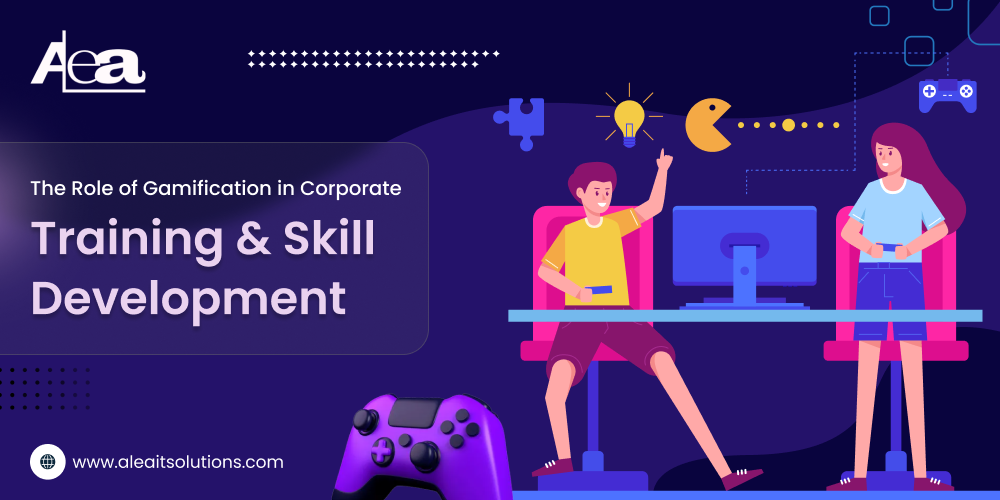Continuous learning and skill development are more important than ever in the fast-paced, constantly-changing corporate world. Conventional training techniques occasionally produce mediocre results because they are tedious and don’t fully engage employees. Gamification can help with this.
The process of incorporating game-like features—like leaderboards, levels, points, and rewards—into non-gaming contexts is known as gamification. Businesses can give their employees a more immersive and inspiring work environment by adding these captivating components to corporate training programs. The important role gamification plays in corporate training and skill development, as well as how it can change the way employees learn, will be discussed in this blog.
What is Gamification in Corporate Training?
The use of game mechanics and principles to promote engagement, improve learning, and boost employee performance is known as “gamification” in corporate training. It transforms conventional training materials into engaging experiences where staff members compete, earn rewards, and overcome obstacles. Gamification increases learning engagement and motivates staff to stick with the training process by introducing components like points, badges, or even achievement levels.
Benefits of Gamification in Corporate Training
- Enhanced Employee Engagement: The increase in employee engagement is one of the main advantages of gamification in training. Conventional training methods, like seminars and presentations, can frequently be uninteresting and passive. Employees can actively participate in gamified training, though, which can enhance learning and leave a lasting impression. Employees are encouraged to work harder and finish training modules successfully when they have the chance to compete for points or rewards.
- Better Knowledge Retention: Because gamified learning is typically more immersive and interactive, information is retained better. Employees are more likely to retain the information when they are actively participating in their education. Repetition, incentives, and challenges all work together to improve memory and help workers hold onto information and abilities for extended periods of time.
- Promotes Healthy Competition: Including challenges and leaderboards in the training process can help staff members feel like they are competing with each other in a friendly way. Employees push themselves to finish training modules more accurately and efficiently as they aim to receive rewards or move up the leaderboard. A more motivated workforce and improved overall performance can result from this competitive spirit.
- Personalized Learning Experience: Training can be tailored to each employee’s needs thanks to gamification. Employers can adjust challenges to employees’ skill levels and let them advance at their own speed by implementing gamified systems. Employees are able to interact with content that is most pertinent to them, whether that be finishing a module or becoming proficient in a particular skill, which enhances results.
- Enhanced Motivation and Productivity: Encouraging staff to finish extended training programs is one of the difficulties that companies encounter. Businesses can offer instant gratification in the form of badges, points, or other rewards by incorporating gamification. When workers see measurable results from their efforts, this ongoing feedback loop increases motivation. They are therefore more likely to stick with the training, which boosts output and skill development.
- Encourages Cooperation and Teamwork: A lot of gamified corporate training courses include cooperative team-based tasks. Workers can cooperate to accomplish tasks, solve issues, and reach objectives. This promotes a feeling of unity and teamwork, which results in better cooperation and communication at work.
- Real-Time Analytics and Feedback: Gamified training programs frequently incorporate real-time analytics, which let staff members monitor their development and pinpoint areas in need of improvement. Gamification platforms can also be used by employers to collect useful information about worker performance. Businesses can use these analytics to evaluate the success of training initiatives and make informed decisions about upcoming development projects.
Examples of Gamification in Corporate Training
- Salesforce’s Trailhead: Using its Trailhead platform, Salesforce, a world leader in customer relationship management (CRM), incorporates gamification. Customers, partners, and staff can participate in interactive modules, level up their skills, and earn badges. Learning has become more interesting and accessible thanks in large part to this gamified training platform.
- Employee Language Training with Duolingo: The well-known language-learning app Duolingo employs gamification through the use of levels, points, and daily streaks. Companies are using Duolingo’s approach to teach their staff new languages. The app’s reward system encourages staff members to keep learning, which guarantees that language proficiency is retained over time.
- Cisco’s Gamified Cybersecurity Training: One of the world’s leading IT and networking companies, Cisco has incorporated gamification into its cybersecurity training initiatives. Through interactive challenges and scenarios, staff members gain knowledge about recognizing and managing possible cyberthreats. Employee performance and training module completion are enhanced by the program’s competitive element.
How to Implement Gamification in Corporate Training
- Establish Clear Goals: Organizations must establish clear goals for their training program prior to gamification. The goals should be in line with the company’s objectives, whether that means learning a new software program, honing technical skills, or improving customer service abilities.
- Include Progression Mechanics: Throughout the training, staff members ought to be able to monitor their own advancement. Make use of points, badges, and levels to help them see their progress and inspire them to keep learning.
- Make Interesting Challenges: Construct scenarios and challenges that are interesting and pertinent. In order to help employees develop practical skills, these challenges ought to be interactive and created to mimic real-world tasks.
- Reward Success: Give praise and incentives for reaching significant goals. Badges, certificates, and material incentives like discounts, gift cards, or more educational opportunities are all examples of rewards.
- Use Analytics for Continuous Improvement: Track employee engagement and performance using analytics. Utilize this information to enhance the gamified learning process and make sure it stays applicable and successful.
Conclusion
Corporate training is being revolutionized by gamification, which makes it more dynamic, captivating, and efficient. Businesses can boost motivation, improve knowledge retention, and increase employee engagement by implementing game mechanics like leaderboards, challenges, and rewards. In the end, it helps workers develop the abilities they need to succeed by promoting healthy competition and teamwork.
At AleaIT Solutions, we specialize in creating tailored gamification solutions that can enhance your corporate training and development programs. Reach out to us today to see how gamification can benefit your business!




